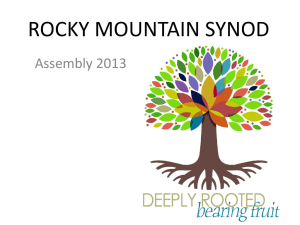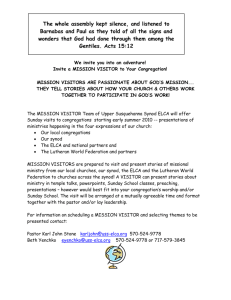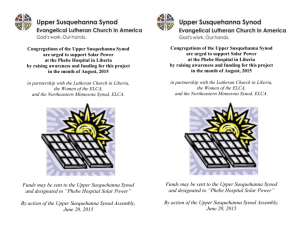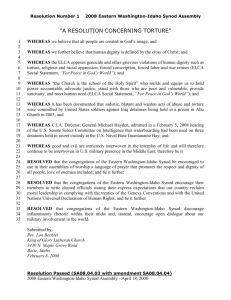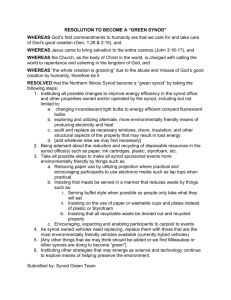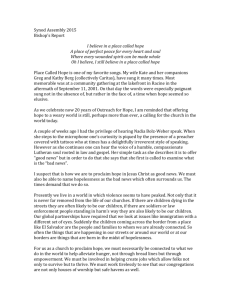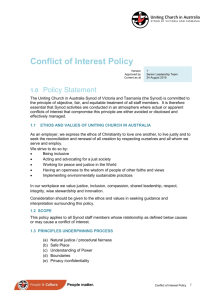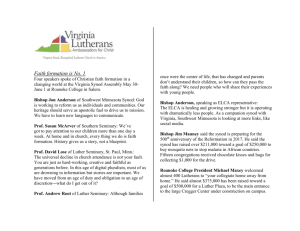ELCA Virginia Synod African American Outreach Strategy
advertisement
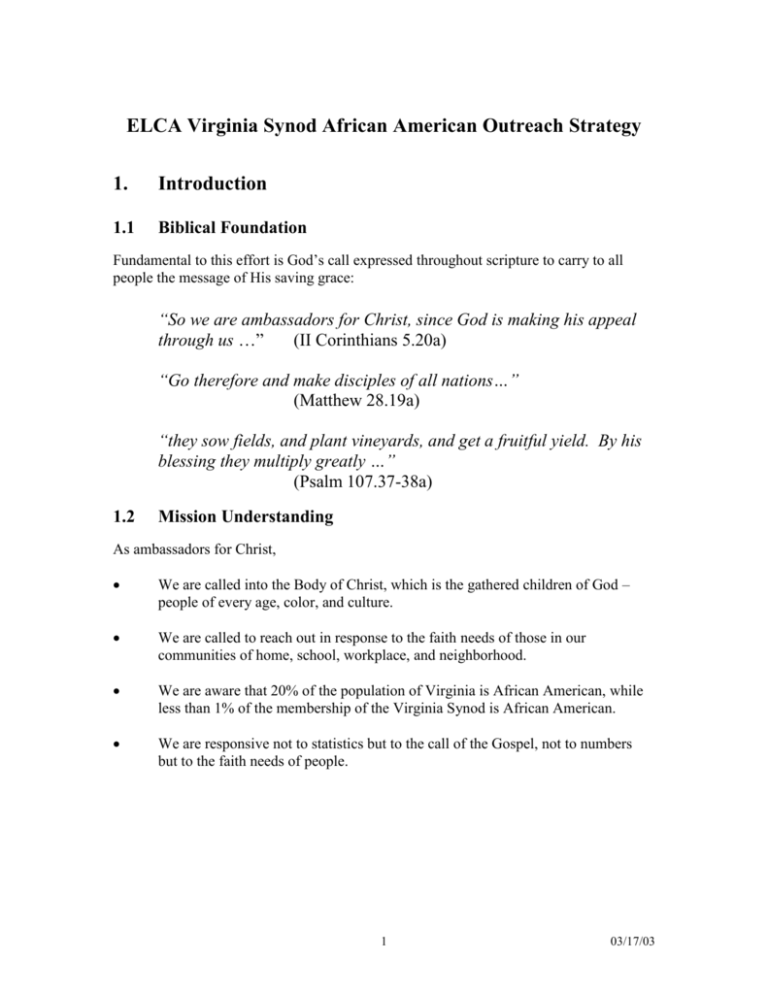
ELCA Virginia Synod African American Outreach Strategy 1. Introduction 1.1 Biblical Foundation Fundamental to this effort is God’s call expressed throughout scripture to carry to all people the message of His saving grace: “So we are ambassadors for Christ, since God is making his appeal through us …” (II Corinthians 5.20a) “Go therefore and make disciples of all nations…” (Matthew 28.19a) “they sow fields, and plant vineyards, and get a fruitful yield. By his blessing they multiply greatly …” (Psalm 107.37-38a) 1.2 Mission Understanding As ambassadors for Christ, We are called into the Body of Christ, which is the gathered children of God – people of every age, color, and culture. We are called to reach out in response to the faith needs of those in our communities of home, school, workplace, and neighborhood. We are aware that 20% of the population of Virginia is African American, while less than 1% of the membership of the Virginia Synod is African American. We are responsive not to statistics but to the call of the Gospel, not to numbers but to the faith needs of people. 1 03/17/03 1.3 Purpose The strategy for outreach to the African American population of Virginia outlined in this document should be viewed in context of the overall strategy of the Evangelical Lutheran Church in America (ELCA) to stimulate the development of diverse worshipping communities that reflect the populations in whose midst they live and serve. Because outreach to groups with their own unique histories, distinct cultural characteristics, and gifts requires knowledge and understanding, the development of strategies tailored to several major cultural/ethnic groups was considered appropriate. Specifically, the ELCA National Division for Outreach has encouraged the development, by each of the Synods, of strategies for reaching out to populations such as African Americans, Latinos, Asians, and Native Americans, to assist in sharing the message of God’s saving grace with all sisters and brothers in Christ. This African American Outreach Strategy for the Virginia Synod should therefore be seen as critical to the outreach of the entire church. It is designed to assist Virginia Synod churches in acquiring the sensitivity and skills needed for bridge building, and to assist the churches and the Synod leadership in the establishment of new mission congregations that welcome all people. 1.4 History In February 2002, with the authorization of the Virginia Synod Council and Bishop James Mauney, and as the representative of the national church who directs outreach for Virginia and North Carolina, Pastor Henry Boschen sent out a letter to Virginia Synod churches inviting interested participants to an initial meeting to discuss ministry with African American people in the Virginia Synod area. In response to the February 2002 letter, a group of people (including Rev. Taylor Harmon, Associate Executive Director of the Division for Outreach-ELCA and leader of the ELCA African American Strategy Team, Bishop Mauney, and Bishop's Assistant Pastor Chip Gunsten) met at Peace Lutheran Church, Charlottesville, on March 17, 2002. Essentially the same group met again on May 29, 2002, at Resurrection Lutheran Church, Fredericksburg, Virginia -- at which time a smaller working group, the Virginia Synod African American Strategy Development Team, was formed to develop the Strategy/Plan. The team, which is accountable to Bishop Mauney, will field test the plan (including presentation to the group that met at Charlottesville) prior to its submission for Synod Council approval in March 2003, and Synod Assembly approval, May 30-June 1, 2003. Strategy Development Team members and the churches they represent are as follows: Shelley Fields (Chairperson), Resurrection Lutheran Church, Fredericksburg Pastor Henry Boschen, National Division for Outreach, ELCA Janice Bunting, Reformation Lutheran Church, Newport News Dierdre Fields, Resurrection Lutheran Church, Fredericksburg 2 03/17/03 Pastor Chip Gunsten, Office of the Bishop, Virginia Synod Lee Himes, Resurrection Lutheran Church, Fredericksburg Esther Johnson, Resurrection Lutheran Church, Fredericksburg Isiah Johnson, Resurrection Lutheran Church, Fredericksburg Henry Jud, Our Saviour Lutheran Church, Warrenton Melinda Jud, Our Saviour Lutheran Church, Warrenton Bill Smith, St. Peter’s Lutheran Church, Stafford 1.5 Mission Context 1.5.1 Demographic Characteristics of the Virginia Synod For a revealing sample of statistical data showing African American population and ELCA baptized membership for counties in the Virginia Synod, refer to Appendix A. For statistical data showing the zip codes in Virginia with the largest projected growth in African American population, refer to Appendix B. I.5.2 Institutional Structure/Leadership Support The Office of the Bishop, Virginia Synod, supports without reservation this outreach mission to reflect the communities in which we live and serve. It therefore commits to a partnership in which it will assist with advisory personnel and other resources to educate and equip Synod churches. Authority for the outreach mission originates from the Synod Assembly, whose role it is to challenge the churches to take the specific steps needed to carry it out, eliminating divisive lines between them and their communities. 1.5.3 Assessment of Synod Human and Financial Resources An item for personnel and other expenses needs to be included in the Synod budget, via a Virginia Synod Mission Committee request. 3 03/17/03 2. African American Outreach Mission Statement The church, as the Body of Christ, is called to reflect the community in which it lives and shares and serves; therefore, conscious of our discipleship, As ambassadors for Christ, We seek to encourage and support congregations of the VA Synod to become: more intentional in outreach to African American people of God in the surrounding community, more responsive to the unique needs and gifts of African American sisters and brothers in Christ, and more effective in offering welcome and full inclusion of all in participation and leadership, through the Holy Spirit. We also seek to encourage and assist the VA Synod to develop: new mission congregations in communities with high percentages of African American population and the need for a congregational presence. 4 03/17/03 3. Goals and Objectives We seek to carry out our Mission Statement through goals and objectives that include but are not limited to those described below. 3.1 Encourage and support congregations of the VA Synod to become: A. B. More Intentional In Outreach To African American People of God in the Surrounding Community (1) Use existing means of communication to increase awareness of multicultural programs and resources (publications – e.g., Journey Together, Update, VA Lutheran – and events, such as the Power in the Spirit conference, the Synod Assembly, Winter Celebration, Seventh Day, Bishop’s Day, National Youth Gathering, and others). (2) Develop a newsletter, web page, and/or other resources to encourage congregational sharing of ideas, programs, and people and material resources for multicultural mission and ministry. (3) Encourage faith sharing and invitation to all of God’s people in the surrounding community. (This might include, but should not be limited to, knocking on doors, distributing flyers, and picking up children for Sunday School.) (4) Encourage worship, Christian education, and fellowship gatherings which celebrate and are sensitive to the cultural diversity of church and community. (The Lutheran Human Relations Association, Greensboro, N.C., might be a helpful resource.) (5) Offer ELCA information, resources, and awareness when appropriate at local and state gatherings (e.g., NAACP and other). (6) Emphasize prison ministry and halfway homes. (7) Encourage meeting shelter, food, and clothing needs. More Responsive to the Unique Needs and Gifts of African American Sisters and Brothers in Christ (1) Increase awareness and understanding of African American culture, along with recognition that it is itself diverse and multi- 5 03/17/03 faceted, not monolithic. Again, the Lutheran Human Relations Association might be of help. Publications such as The Heritage and Culture of African Americans in Virginia, issued by the Virginia Tourism Corporation in Richmond, will also prove useful. Activities might include visiting churches of other denominations, and conducting musical sharing – e.g., with predominantly African American congregations – as part of a “Getting to Know Your Neighbor” initiative. (For a list of African American and multicultural resource materials, see Appendix C.) C. (2) Encourage use of African American worship resources such as This Far By Faith. A workshop on the use of such resources could be included at the Power in the Spirit conference. (For a list of African American and multicultural worship and music resources, see Appendix D.) (3) Encourage the use of multicultural Christian Education resources. (4) Support youth ministry with African American young people. (5) Establish and support campus ministry on African American College campuses. (6) Encourage and support fully-inclusive ministries on all Virginia Synod college campuses. More Effective in Offering Welcome and Full Inclusion of All in Participation and Leadership Through the Holy Spirit (1) Encourage greeting visitors and calling at homes. (2) Encourage worship and music enhanced and enlivened by African American and multicultural resources – using the gifts of all the people to express the Word in a powerful, multi-dimensioned way that opens up the meaning of the text for the day. (3) Encourage the development of culturally diverse committees, and task and fellowship groups -- recognizing that accomplishing prior goals listed within this “Goals and Objectives” section will facilitate greatly. 6 03/17/03 3.2 Encourage and assist the VA Synod in the development of new mission congregations in communities with high percentages of African American population and the need for a congregational presence A. Identify and equip African American persons for rostered leadership (ordained pastors, associates in ministry, and diaconal ministers) and lay leadership within the church. B. Support the use of African American Mission Developers in the establishment of these mission congregations. 7 03/17/03 4. Outreach Strategy The recommended strategy for carrying out the Mission Statement and the specific goals identified in Section 3 is defined below. 4.1 Starting New Mission Congregations The initial strategy for new missions is to establish a multicultural congregation with an African American pastor in Chesterfield County or the Tidewater region of Virginia – areas with high projected growth of African American population. (see Appendix B). The Office of the Mission Director, Virginia Synod, will develop an appropriate proposal. Existing churches may be used to help with establishing this and additional mission congregations. 4.2 Growing and Strengthening African American/Black ministry in Established Congregations The strategy is to seek to sensitize and equip existing congregations in areas of significant African American population, to enable them to reach out effectively in their communities. Specific suggestions include but are not limited to the following: Request assistance from the Virginia Synod Evangelism Committee and Missions Committee to provide multicultural specialists to speak on African American and other varieties of cultural sensitivity at such events as: - The Pre-Lenten Conference of all synod rostered leaders - The Synod Assembly - A workshop conducted for leaders from churches throughout the Virginia Synod -- to include a breakout session on effective integration of African American and multicultural worship styles and music with Lutheran liturgy. (For a list of African American and multicultural worship resources, see Appendix D.) Query an existing congregation that has already carried out this type of outreach successfully (e.g., Resurrection Lutheran Church, Fredericksburg, VA, and/or St. Peter’s Lutheran Church, Stafford, VA). Conduct follow-up retreats/seminars to provide information on materials and methods (e.g., providing daycamps and daycare; creating web sites and brochures characterized by diversity, including photos/illustrations showing people of color; and effective welcoming of all who come in the door). 8 03/17/03 4.3 Staffing for Leadership The strategy is to be accomplished through a multi-pronged effort, including, but not limited to, the following: 4.4 Volunteer lay people from churches throughout the VA Synod Recruits for ministry Virginia Synod Ministry Candidacy Committee Scholarship recipients Resource people from the Virginia Synod Staff and the ELCA Members of the VA Synod African American Outreach Strategy Development Team and the original group who met in Charlottesville Establishing a Financial Basis Funding for implementation should be provided through the Division for Outreach, the Virginia Synod Mission Committee, congregations and conferences, and application for grants. 4.5 Implementing: Creating the Team and Plan Implementation shall be coordinated by a core group of committed volunteers under the authorization of the Virginia Synod. This core group might include members from the Strategy Development Team, the original group of people who met in Charlottesville on March 17, 2002, and volunteers recruited from Virginia Synod congregations (including members of Outreach and Worship and Music committees). The implementation process may include but not be limited to: Development of a plan outlining specific steps needed to carry out the Outreach Strategy Formation of Implementation Task Groups, taking existing groups into account. Allocation of efforts (portions of the Outreach Strategy implementation and/or specific goals) to the Task Groups. Establishment of a timeline for the steps of implementation. Motivation of participation, possibly including a Day Retreat during which all Task Groups meet to present their goals and discuss possible sharing of resources and opportunities for synergy. Evaluation of Results 9 03/17/03 5. African American Outreach Strategy Committee Process 5.1 Complete Preliminary Plan 5.2 Field Test Preliminary Plan Obtain sample reactions from the original group that met, along with Pastor Taylor Harmon, Bishop James Mauney, and Pastor Chip Gunsten, at Peace Lutheran Church in Charlottesville, on March 17, 2002. Also provide the Plan to Pastor Taylor Harmon for review by the National Division of Outreach’s African American/Black Outreach Strategy Team on March 22, 2003. 5.3 Obtain Synod Council Support Present the field-tested Plan to the Virginia Synod Council in March 2003. 5.4 Obtain Synod Assembly Approval and Support Pending Virginia Synod Council approval and support, present the Plan to the Synod Assembly scheduled for May 30-June 1, 2003. 5.5 Distribute Final Strategy Plan Pending review and approval by the Virginia Synod Assembly, the Strategy Plan will become available to all congregations, institutions, and agencies of the synod. 10 03/17/03 Appendix A: African American Population and ELCA Baptized Membership in Counties of the Virginia Synod 11 03/17/03 12 03/17/03 Appendix B: Zip Codes in Virginia with Largest Projected Growth in African American Population (Also see the U.S. Census Bureau’s web site entitled “Race and Hispanic Origin Population Density of the United States, 1990,” www.census.gov/geo/www/mapGallery/RHOriginPD-1990.html) 13 03/17/03 14 03/17/03 Appendix C: African American and Multicultural Resource Materials 15 03/17/03 African American and Multicultural Resource Materials Books The following references are from Augsburg Fortress’s web site (www.augsburgfortress.com): Chinula, Donald M. Building King’s Beloved Community: Foundation for Pastoral Care and Counseling with the Oppressed, United Church Press, 1999. Choy-Wong, Kathryn. Building Bridges: A Handbook for Cross-Cultural Ministry, Judson Press, 2000. DeYoung, Curtiss Paul. Coming Together: The Bible’s Message in an Age of Diversity, Judson Press, 2000. ELCA. Multicultural Education Guide, 1997. ELCA. Multicultural Mission Strategy: A Strategy for Proclamation of the Gospel,1991. Law, Eric H.F. The Bush Was Blazing But Not Consumed, Chalice Press, 1997. Matsuoka, Fumitaka. The Color of Faith: Building Community in a Multiracial Society, United Church Press, 2000. Montgomery-Fate, Tom. Beyond the White Noise: Mission in a Multicultural World, Chalice Press, 2000. Patterson, Sheron C. New Faith: A Black Christian Woman’s Guide to Reformation, Re-Creation, Rediscovery, Renaissance, Resurrection, and Revival, Fortress Press, 2000. Toppin, Edgar Allan. The Heritage and Culture of African Americans in Virginia: A Guide to the Sites, Virginia Tourism Corporation (www.VIRGINIA.org, or 901 East Byrd Street, Richmond, VA 23219), 2001. Web Sites www.africana.com www.americanhistory.si.edu/paac (The Smithsonian Institution’s Program in African American Culture) 16 03/17/03 www.si.edu/opa/afafam (The Smithsonian Institution’s African and African American Resources web site) Museums Anacostia Museum and Center for African American History and Culture Southeast Gallery: 1901 Fort Place S.E. Washington, D.C. 20560-0520 National Mall Gallery: Arts and Industries Building, Room 1130, Washington, D.C. 20560-0431 Center for Folklife Programs and Cultural Studies, Smithsonian Institution, 955 L’Enfant Plaza, S.W., Suite 2600, Washington, D.C. 20560-0914 17 03/17/03 Appendix D: African American and Multicultural Resources for Worship and Music 18 03/17/03 African American and Multicultural Resources for Worship and Music Books Dawn, Marva. Reaching Out Without Dumbing Down, ELCA and LCMS. This Far by Faith: An African American Lutheran Resource for Worship, Augsburg Fortress, 1999. This supplemental volume gathers and makes available the abundant gifts of African American worship and song. The book contains both a rich liturgical section as well as a large body of new and old hymns and songs. The resource has been developed through the partnership of the ELCA Division for Congregational Ministries, ELCA Commission for Multicultural Ministries, and the Lutheran Church Missouri Synod Board for Black Ministry Services. Videos Dawn, Marva. A Theology of Worship for the 21st Century, ALCM Wengert-Dawn Addresses, June 22-24, 1998, Studio South Video Services, 4030 Old Pineville Road, Charlotte, N.C. 28217, 704 525-0296. Organizations ELCA Commission for Multicultural Ministries ELCA Division for Congregational Ministries LCMS Board for Black Ministry Services Web Sites www.augsburgfortress.org www.elca.org 19 03/17/03
